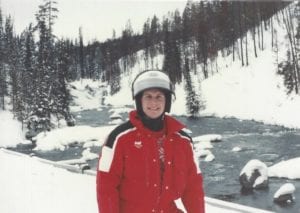My name is Stefan, and I was diagnosed with Klinefelter Syndrome (KS), also known as XXY, in February 1996 at 25. Throughout my life, from birth through age 25, my parents knew I had learning, social, anger, and behavioral issues. They couldn’t grasp it until I received my Klinefelter Syndrome diagnosis. When I was diagnosed, I was initially angry that it took so long to be diagnosed. None of the medical professionals felt they should do genetic testing to determine my diagnosis. I grew up in Baltimore, Maryland, home of Johns Hopkins Hospital, a world-renowned hospital facility.
 Putting a name to this condition finally answered many of my lifelong struggles. It put a face on my experiences that significantly affected my life.
Putting a name to this condition finally answered many of my lifelong struggles. It put a face on my experiences that significantly affected my life.
The day I finally received my diagnosis is a day I will never forget. My primary care physician diagnosed me. I had been seeing this physician for the previous seven years. When I presented with chest pains after extreme physical exercise (shoveling snow!), he said he didn’t feel my testicles were an abnormal size in prior years. He sent me for a semen analysis and then a buccal smear. When the buccal smear was inconclusive, he ordered a blood karyotype to determine my definitive diagnosis of Klinefelter Syndrome.
It showed Klinefelter Syndrome 47XXY! I have since learned that I am a variant of Klinefelter Syndrome called mosaic. Mosaic is when part of your cells tested are parts of two or more variants. Of my 20 cells tested, 5% are 46XY, and 95% are 47XXY, making my Klinefelter Syndrome signature 46XY/47XXY.
I was my doctor’s first diagnosed patient in over 20 years of practice. When he called me on the telephone to inform me of my diagnosis and set up an appointment in his office, he told me he didn’t know much about this condition. He said, you are sterile and cannot father children, and I don’t know anything else. He then hung up the phone, and I stared into space, contemplating what he had just said! Looking back on that day, I am angry that a doctor would tell a patient that over the phone without any other supporting information.
I did follow up with that diagnosing physician and had hoped he would have done some research before seeing me. But, unfortunately, he had not. He just told me to drop my pants so he could give me a monthly testosterone injection. I declined to indicate that I had scheduled an appointment with a top adult endocrinologist at Johns Hopkins Hospital. I wanted to see a knowledgeable specialist and get a treatment recommendation.
The specialist I saw was extremely knowledgeable and gave my parents and me lots of information. I started understanding how my life began to come together with this new diagnosis. The endocrinologist felt like I should start on the Androderm patch. This patch was new and gave me a daily dosage of testosterone. She initially felt that would be my best choice and to see how that went. So, I started testosterone therapy within about six weeks of diagnosis. The boost of testosterone felt terrific!!!
But the Androderm patches were terrible and significant and caused itching and irritation, and rashes on my skin. After a week or two, I contacted my endocrinologist and told her I needed to try a different method. I couldn’t continue using these Androderm patches. They were horrible! She scheduled an appointment for the following week for me to meet with her nurse. Her nurse taught me how to inject intramuscular (IM) testosterone. She taught me, which seemed pretty straightforward and something I could manage to do at home. I did these injections every 2 weeks, and I didn’t have to worry about the patch irritation or practically waxing various parts of my body when ripping off these patches!
Initially, my parents didn’t want me to tell many people after my diagnosis occurred. Since I was diagnosed a month before my 26th birthday, I needed to consider what was best for me going forward. I initially honored their wishes and didn’t tell many people about it. But within a month of my diagnosis, I realized I needed support. I needed to talk to others about the condition and how it affected me — at least from what I knew early on.
As it was today in 2019, the internet didn’t exist in February of 1996 when I was diagnosed. There was one website with some information. That was the website of Klinefelter Syndrome & Associates (KS&A). The first organization was formed to support and helping to educate those who had been diagnosed with the condition.
I found the name of someone I’ve called a friend for the past 23 years through the website. David Wright, a support group leader for the Silver Spring, Maryland Klinefelter Syndrome Support Group. Unfortunately, my diagnosis occurred a few days after he had held a support group meeting. But his telephone numbers for both home and work were on the website. So I took the opportunity to contact him at work. I was still timid and quiet then, so I was nervous about calling and talking with him about Klinefelter Syndrome. But my friend was warm and welcoming, making me feel “normal.” He answered my questions and helped me to understand Klinefelter Syndrome or KS or XXY the best I could.
He and I spent about 45 minutes on the telephone. I’ve always looked back on that conversation as the gateway to becoming an expert in Klinefelter Syndrome.
I then started to learn about and get a grasp on the condition. It was indeed a relief and blessing that my diagnosis finally occurred. I could finally put a name to something I had been living with since birth. I fully understand now, at age 49, how much of a relief this diagnosis has been. Though when my diagnosis occurred, it was difficult and required a period of adjustment to fully understand and deal with what this really meant. I still wasn’t sure what effect it would have on my life in the future.
Now in 2019, as I rewrite “my story,” testing for and receiving a diagnosis of XXY or Klinefelter Syndrome is a little easier. However, many boys/men worldwide still aren’t being diagnosed, and it is very frustrating! It is still considered a rare genetic condition even though it occurs in roughly 1 in 500 live male births.
Though Klinefelter Syndrome, or XXY, is more known now than it was at my diagnosis, there is still much to learn and teach others. I determined very quickly that the best way to help myself deal with the condition is to help others with it. To spread the word that having this condition isn’t all that bad.
My goals since my diagnosis have always been to educate, educate, and educate! Getting the word out and making myself available and known, as well as the organizations know, is what I continually try to do. My goals are to help those just finding out not to feel alone and to cope with their diagnosis of this rare genetic condition.
Continued in Part 2: Living with Klinefelter Syndrome

